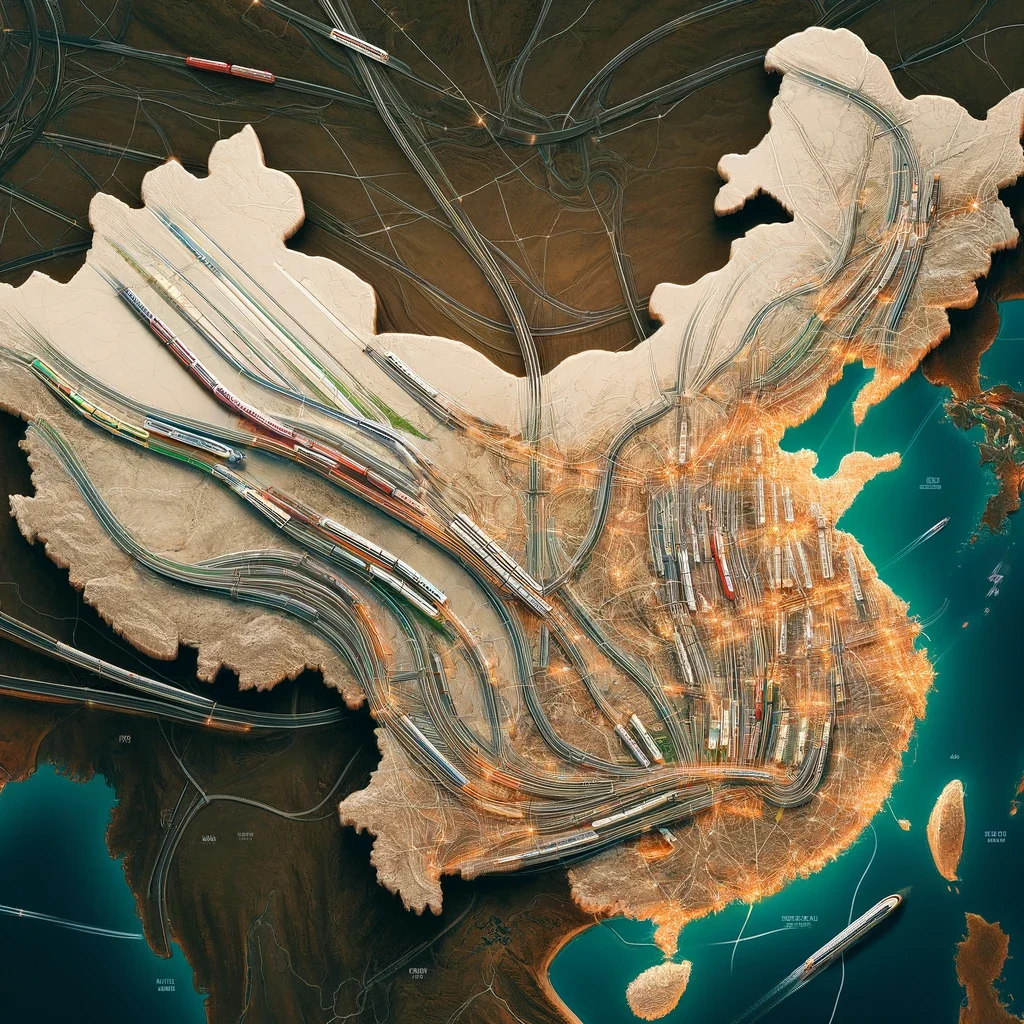Contents
Introduction:
Throughout human history, each era has its monumental achievements. In ancient times, there was the Great Wall; today, there is the high-speed rail. The emergence of China’s high-speed rail has not only reshaped the country’s transportation landscape but also become a global focal point. Within just over a decade, the Chinese people, relying on their efforts and wisdom, have invested vast resources into the construction of high-speed rail, achieving remarkable success. In fact, the rapid development of China’s high-speed rail has not only transformed the national transportation pattern but has also profoundly impacted the socio-economic landscape. So, why has China been able to build the world’s largest and fastest high-speed rail network in such a short time? The answer lies in the collective effort of China’s 1.4 billion people and the country’s strong mobilization capabilities. China’s high-speed rail is not just a mode of transport; it is an engine for economic development and a catalyst for social change. It connects bustling cities with remote villages, shortens the distance between time and space, making people’s lives more convenient and the economy more prosperous. At the same time, the rapid development of China’s high-speed rail has profoundly influenced the socio-economic fabric of the nation. In just over a decade, the mileage and speed of China’s high-speed rail have reached the top in the world. This article will explore the development history, core achievements, and the societal changes brought by China’s high-speed rail in detail, and look forward to future development directions and challenges. Let’s delve into the story and significance behind this modern “Iron Dragon.”
The Background and Achievements of China’s High-Speed Rail Construction
The development of China’s high-speed rail has benefited from the strong support of national policies and a robust economic foundation. Unlike other major countries such as the United States, Russia, and India, China has demonstrated unique advantages in high-speed rail construction. The centralized power and efficient decision-making mechanism of the state have enabled China to complete large-scale high-speed rail network construction in a short period. In large countries, complex political environments, local interests, and funding issues have slowed high-speed rail progress.
The speed of China’s high-speed rail is impressive, with the highest operational speed reaching 350 kilometers per hour. Currently, China’s total high-speed rail mileage exceeds 40,000 kilometers, covering 95% of cities with a population of over 500,000. This vast network connects not only major cities but also many remote areas. The core reason why other major countries cannot build high-speed rail as quickly as China lies in China’s political system and social structure. The Chinese government can concentrate resources and power, quickly decide and execute large infrastructure projects. Meanwhile, the opening of China’s high-speed rail has greatly facilitated residents of remote areas, allowing them the opportunity to leave their hometowns and integrate into modern society. This has not only enhanced the economic development level of these regions but also improved the living standards of local residents.
As of 2023, China’s high-speed rail network has become the world’s largest high-speed rail network, covering all provinces and major cities nationwide. Chinese state-owned enterprises have played a key role in high-speed rail construction, investing trillions of RMB to build this vast network. For example, traveling by high-speed rail from Beijing to Shanghai, one of China’s busiest high-speed rail routes, covering about 1,318 kilometers, takes only 4.5 hours. From Beijing to Shenzhen, covering about 2,200 kilometers, it takes about 8 to 10.5 hours. Or from Shanghai to Shenzhen, covering about 1,600 kilometers, it takes only about 6.5 hours. In other words, these high-speed rail routes have greatly reduced travel time between cities, allowing people to easily travel between these major cities within a day, which is particularly important for business travel and work exchanges. China’s high-speed rail construction has not only brought significant travel convenience but also spurred economic development and regional balance. Here are the main benefits and core achievements brought by high-speed rail construction:
- Economic Growth: China’s high-speed rail has spurred economic development in cities along the routes, promoting resource flow and industrial cooperation between regions. Statistics show that the GDP growth rate of cities along the high-speed rail is generally higher than that of non-high-speed rail cities.
- Employment Opportunities: The construction and operation of China’s high-speed rail have created numerous job opportunities, including positions directly involved in construction and operation as well as jobs in related industries.
- Regional Balanced Development: China’s high-speed rail connects bustling cities with remote villages, shortening the distance between time and space, promoting resource and talent flow on a larger scale, and fostering regional balanced development.
- Environmental Benefits: As a green transportation method, China’s high-speed rail reduces environmental pollution caused by air and road transport, lowering carbon emissions.
- Social Benefits: China’s high-speed rail has improved people’s quality of life, shortened commuting times, and made travel more convenient, particularly for residents of remote areas, opening the door to the outside world.
We believe that in the future, China’s high-speed rail will continue to expand, with plans to achieve a 3-hour travel circle between major cities nationwide by 2035. China is also actively promoting high-speed rail technology and experience overseas, undertaking high-speed rail projects in multiple countries and regions, further enhancing the global influence of China’s high-speed rail.
The Social Changes Brought by China’s High-Speed Rail
The convenience of China’s high-speed rail has attracted a large number of young people to big cities in search of job opportunities, but it has also brought new challenges. High living costs and intense competition are the main problems they face. For example, in Shanghai, outsiders need to obtain a residence permit to live long-term, and high housing prices and living costs increase their economic burden.
The rapid development of high-speed rail has made travel between cities more convenient, attracting a large number of young people from second- and third-tier cities or even rural areas to first-tier cities like Beijing, Shanghai, and Shenzhen. These cities offer more job opportunities and better development platforms but also bring significant living pressures.
Housing prices and rents in first-tier cities are high, making it difficult for many young people to afford. For instance, in Shanghai, the monthly rent for a small apartment can be thousands of yuan, which is a considerable burden for young people just entering the workforce. Besides housing costs, high living expenses are also a major problem young people face. The costs of dining, transportation, and entertainment in big cities are much higher than in second- and third-tier cities, further increasing the economic pressure.
The convenience of China’s high-speed rail has made big cities magnets for young people but has also brought about social division and urban pressure issues. The influx of a large number of outsiders increases the burden on cities, and the pressure on public services and infrastructure also increases. In China, the household registration system poses significant obstacles for outsiders integrating into big cities. Outsiders need to obtain a residence permit to enjoy some basic public services such as education and healthcare, making it harder for them to live and work in big cities.
Despite improving intercity transportation, the internal transportation pressure in big cities remains significant. Subways and buses are often crowded during peak hours, causing inconvenience for daily commuting.
Although high-speed rail has spurred the rapid development of first-tier cities, it has also exacerbated the imbalance in regional economic development. Some second- and third-tier cities and rural areas still face economic development difficulties due to the lack of sufficient job opportunities and development resources. The convenience of high-speed rail attracts many talented young people to first-tier cities, leading to a brain drain in second- and third-tier cities and rural areas. Consequently, the economic development of these regions is greatly affected.
Large cities concentrate a vast amount of resources and opportunities, while development resources in remote areas are relatively scarce. High-speed rail shortens spatial distances, but economic development gaps still exist. For young people whose hometowns are in rural areas, once they take the high-speed rail to major cities, they may never want to return. This situation leaves the future uncertain.
The Impact of AI Technology on the Future of China’s High-Speed Rail
With the development of AI technology, future transportation methods will undergo significant changes. Autonomous taxis like Tesla Robotaxi are about to be introduced, which will have a profound impact on the traditional job market. The existence of high-speed rail will continue to influence the lives and work styles of Chinese youth, but balancing the rapid development of technology with social needs will be a long-term challenge.
As an efficient and environmentally friendly mode of transport, China’s high-speed rail will remain an important part of the country’s transportation network in the future. However, with the rise of AI and autonomous driving technologies, high-speed rail must constantly adapt and integrate these new technologies to improve operational efficiency and user experience. The introduction of autonomous driving technology will not only change the private car and taxi markets but may also positively impact high-speed rail scheduling and operations. For example, using AI technology for intelligent scheduling and maintenance of high-speed rail can significantly improve punctuality and safety. China’s high-speed rail development needs to consider not only speed and coverage but also social equity and regional balanced development. Through reasonable policies and planning, high-speed rail can become an important force driving social progress and economic prosperity. For instance, in the planning and construction of high-speed rail lines, priority should be given to economically underdeveloped areas to promote economic development and social progress in these regions.
The development of China’s high-speed rail is not just a transportation story; it reflects the speed of national development and social transformation. The convenience and challenges brought by high-speed rail are inevitable phenomena in the modernization process. How high-speed rail further integrates into people’s lives in the future and continues to play its role in the AI era will be a topic worth paying attention to.
- Intelligent Scheduling and Operations: AI technology can be used for intelligent scheduling and maintenance of high-speed rail, improving punctuality and safety. Through big data analysis and machine learning, high-speed rail companies can predict and prevent potential problems, thereby reducing faults and accidents.
- Regional Economic Development: High-speed rail construction should prioritize economically underdeveloped areas to promote economic development and social progress in these regions. High-speed rail can drive economic development along its routes and narrow regional development gaps, promoting balanced development nationwide.
- Social Equity and Inclusion: In the development of high-speed rail, social equity issues must be addressed. The pricing of high-speed rail tickets should consider the affordability of different income groups, ensuring the convenience and inclusiveness of high-speed rail. At the same time, support and protection measures for vulnerable groups should be strengthened to ensure they can also enjoy the convenience brought by high-speed rail, such as wheelchair services for patients or the elderly.
- Medical Emergencies: AI technology can help handle passengers with sudden illnesses on high-speed rail. Through real-time monitoring and data analysis, AI systems can quickly identify emergencies and provide corresponding first aid guidance. Equipping high-speed rail stations and trains with intelligent first aid equipment and robots can provide necessary emergency medical support before professional medical personnel arrive, further enhancing the safety and inclusiveness of the public transportation system.
Conclusion:
Finally, China’s high-speed rail, like a giant dragon, spans the vast land of China, closely connecting every corner. It has not only transformed the face of China but also showcased Chinese speed and miracles to the world. The development of high-speed rail is the crystallization of the wisdom and perseverance of the Chinese people, a symbol of the spirit of modern China. Under global attention, China’s high-speed rail is writing a new chapter in the history of human transportation with its unparalleled speed and scale.
Published by: Mr. Leo Mao. You are welcome to share this article, but please credit the author and include the website link when doing so. Thank you for your support and understanding.



